

Obviously there are personal preferences to take into consideration, for example, some people are happy to live on one meal a day with two liquid ‘shakes’ making up their other meals. Other people like to actually eat food at each meal. Then there are nutritional and health considerations, for example, some diets have extremely low calories or are based on eating one single food, like the Grapefruit Diet which are not nutritionally sound and may even be detrimental for people with fragile health.
Long term success is another factor to consider. Of course, if you go back to your old diet and lifestyle patterns that made you gain weight in the first place any weight loss will be difficult to maintain. In fact up to 95% of all weight loss attempts fail with dieters gaining back all the weight they lost, sometimes more, within 5 years.
But is it the person that fails, or the type of diet? Most common diet programmes offered are based on calorie counting, these programmes slow down the metabolic rate so continued weight loss is very difficult to maintain. Once people go back to a normal calorie intake, their metabolism can’t keep up with the extra energy intake and they start gaining back the weight they lost.
However, a ketogenic based diet is different because it switches the body from burning glucose to burning fat, ensuring muscle mass and metabolic rate are maintained.
Essentially, a ketogenic diet is based on eating a low amount of carbohydrate along with adequate protein. To understand why this is important let’s quickly review the 3 main sources the body burns for energy:
By restricting dietary carbohydrates the body is forced to break down stored glucose (glycogen) and free fatty acids to be used as energy. Once all stored glycogen is used up the body will break down fat tissue for energy; this process in the liver is what produces ketone bodies which are the body’s second choice for energy. These ketones leave the body via the urine which enables us to measure when the body is burning fat. By measuring ketones in the urine with ketone strips you know that you are efficiently burning fat when you are ‘in the pink’.
Restricting calories by simply eating less food is not the answer for long term success; you need to specifically reduce high carbohydrate foods and reduce insulin to ‘switch on’ the fat burning process.
On a good ketogenic diet you still eat three meals a day with an emphasis on lots of green leafy vegetables, lean protein, healthy fats and plenty of water and exercise; making it nutritionally sound and safe for most people to start.
As with any weight loss programme, pregnant and breast feeding women and anyone with serious health conditions should consult with their healthcare provider before commencing.
The similar names means that these two physiological states are often confused. Ketosis is a safe physiological state caused by the regulated and controlled production of ketones during the fat burning process. When fat is broken down the liver produces ketones which the body uses as a fuel for energy. At various times in our life our body will naturally be in a state of ketosis, this is referred to as physiological ketosis and occurs in newborn babies, after exercise and in adults with a low carbohydrate diet.
Ketoacidosis, also referred to as diabetic ketoacidosis is an unsafe condition. It is a feature of uncontrolled diabetes mellitus where the body has increased blood sugar levels, ketone bodies and blood acid levels. Insulin deficiency or resistance is the main cause of ketoacidosis.
Michigan State University ‘The Failures of the Old Paradigm: Are Weight Loss Attempts Effective’. Accessed: 11 Feb, 2010. https://www.msu.edu/user/burkejoy/unit3a_2.html
McDonald L (1998) The Ketogenic Diet: A Complete Guide for the Dieter and Practitioner, Lyle McDonald, Austin, TX.
The Medical Biochemistry Page ‘Gluco neogenesis’, last updated 2 November, 2009. Accessed: 12 February, 2010. http://themedicalbiochemistrypage.org/gluconeogenesis.html
Strain J, Caballero B, Sadler M (Eds) (2005) Encyclopedia of Human Nutrition, Elsevier, Oxford: Williamson DH “Ketosis”, vol 1, pp 91-98.